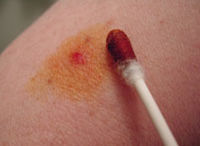
Photo from wikipedia
BACKGROUND Needleless connectors (NCs) were introduced to reduce health care work needlestick injuries (NSIs). If not decontaminated prior to use, NCs can be a portal for patient blood stream infections.… Click to show full abstract
BACKGROUND Needleless connectors (NCs) were introduced to reduce health care work needlestick injuries (NSIs). If not decontaminated prior to use, NCs can be a portal for patient blood stream infections. The optimal disinfectant, and its application duration, for NC decontamination has not been empirically established. METHODS Factorial design randomized controlled trial comparing 70% isopropyl alcohol (IPA) and 2% chlorhexidine gluconate (CHG) in 70% IPA for 5, 10, or 15 seconds, in adult medical patients with peripheral intravenous catheters. RESULTS At baseline, 153 of 300 NCs (51%) grew microorganisms commonly found on the skin. Decontamination was successful in 150/153 (98%). There was no significant difference in decontamination between 70% IPA or 2% CHG in 70% IPA (P = .62), or decontamination for 5, 10, or 15 seconds (P = .21). CONCLUSIONS There was no difference in the effectiveness of 70% IPA and 2% CHG in 70% IPA for NC decontamination for peripheral intravenous catheters in the clinical environment. Successful decontamination was not different for applications of 5, 10, and 15 seconds; 15 seconds did not always remove all microorganisms. Factors such as cost, feasibility of compliance, and low risk of allergy support 5 seconds decontamination with 70% IPA as an acceptable approach.
Journal Title: American journal of infection control
Year Published: 2020
Link to full text (if available)
Share on Social Media: Sign Up to like & get
recommendations!